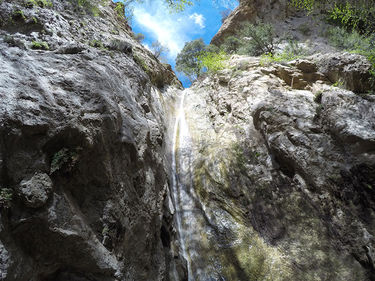RedRock Canyon
| Rating: | ||||
|---|---|---|---|---|
| | Difficulty:3B V (v3a2 V) Raps:13-14, max ↨125ft
Red Tape: Shuttle: | |||
| Location: | ||||
| Condition Reports: | 24 Jun 2017
"extracts from Facebook posts, click link for full details (privacy restrictions may apply). "Red Rock Canyoneering Restoration Project : I changed |
|||
| Best season: | ||||
| Regions: | ||||
Introduction[edit]
A remote technical canyon rich in history.
Nestled north of Castaic Lake in California lies a vast and remote wilderness that whispers tales of ancient history, echoing the footsteps of indigenous peoples, miners, and Spanish explorers. This untamed landscape, marked by its rugged terrain and untouched beauty, serves as a testament to the resilience of nature and the layers of human history woven into its fabric.
The remoteness of this wilderness is a defining characteristic, where the modern world seems to fade away, leaving only the untouched wilderness to thrive. As one ventures deeper into this wild expanse, the remnants of a bygone era come to life, providing a glimpse into the rich tapestry of human habitation that dates back thousands of years.
Long before the arrival of Europeans, Native American communities thrived in harmony with the land, leaving behind traces of their existence through artifacts and sacred sites. The silent whispers of the wind seem to carry the stories of their daily lives, survival techniques, and spiritual practices that connected them intimately with the natural world.
The lure of mineral wealth later drew miners to this remote region during the 19th century, leaving behind remnants of their mining endeavors. Rusting equipment and dilapidated structures stand as silent witnesses to the bustling activity that once echoed through the canyons and hills. The mining history of this area adds an industrial layer to its narrative, as if the earth itself holds the scars of the pursuit of precious resources.
Delving further into the past, the Spanish influence becomes evident, weaving another strand into the tapestry of this wilderness. Spanish explorers, driven by the thirst for discovery and expansion, left their mark on the landscape. Missionaries, seeking to spread their influence, encountered the indigenous people of the region, leading to a complex intermingling of cultures.
As the sunlight filters through the dense canopy of trees and the rustling leaves carry the echoes of a bygone era, the remote wilderness north of Castaic Lake invites exploration and reflection. It stands as a living testament to the interconnected history of indigenous peoples, miners, and Spanish explorers, each leaving their unique imprint on the land, creating a narrative that transcends time. This remote wilderness is not merely a place; it is a living museum, a sanctuary for the echoes of the past to linger and whisper their stories to those who are willing to listen.
Approach[edit]
Descent[edit]
Exit[edit]
Red tape[edit]
Beta sites[edit]
Trip reports and media[edit]
Background[edit]
In addition to its rich historical tapestry shaped by indigenous peoples, miners, and Spanish explorers, the remote wilderness north of Castaic Lake has also witnessed the contributions of modern explorers. Among these, the names Matt Maxon, Bernd Haase, Ron Lebfrom, and Conrad Wentzel stand out as pioneers who etched their own chapters into the narrative of this wild expanse.
In an era where the lure of exploration still beckoned, Matt Maxon, alongside Bernd Haase, played crucial roles in uncovering the secrets hidden within the heart of this wilderness. Fueled by the spirit of adventure, they ventured into uncharted territories, equipped not only with a thirst for discovery but also with the technical expertise needed to navigate the rugged terrain.
Matt Maxon, a visionary explorer, meticulously planned the route after several probes in the area, alongside Bernd Haase. Their collective efforts aimed to understand the intricacies of the landscape, ensuring a safe and informed exploration of the remote wilderness.
The significance of their planning became evident in the exit phase, where Matt Maxon and Ron Lebfrom took on the task of clearing the path. Their efforts were focused on ensuring that the exploration team did not encounter a formidable wall of brush obstructing their exit. The meticulous preparation by Maxon and Lebfrom exemplified their dedication to creating a seamless exploration experience, navigating through the challenging terrain with precision.
Ron Lebfrom, displaying resourcefulness, made a water drop on top of the ridge to sustain overnight camping during the probe of the upper part of the canyon. This strategic move highlighted the explorers' commitment to self-sufficiency, allowing them to delve deeper into the wilderness while establishing a base for further investigation.
Moreover, the first descent of Redrock Canyon marked a significant milestone in the exploration of this formidable wilderness. Ron Lebfrom, alongside Conrad Wentzel and the collaborative efforts of Matt Maxon and Bernd Haase, accomplished the remarkable feat, adding a modern chapter to the region's exploration history.
The stories of Matt Maxon, Bernd Haase, Ron Lebfrom, and Conrad Wentzel join the echoes of ancient history. Their contributions, both in technological innovation and firsthand exploration, intertwine with the tales of indigenous peoples, miners, and Spanish explorers. The remote wilderness north of Castaic Lake thus becomes not only a sanctuary for the whispers of the past but also a living canvas upon which modern explorers continue to paint stories of courage, curiosity, and a profound connection to the untamed beauty of the land.
First Descent by Ron Lebfrom and Conrad Wentzel
Probe and clearing of brush on the exit by Matt Maxon and Ron Lebfrom
RedRock Canyon contains mines believed to be of Spanish origin, attracting numerous explorers who have sought to reach them. The waterfalls have consistently posed challenges for mine exploration. The legendary Hugh Blanchard possesses extensive information on the various attempts to explore the mines in RedRock Canyon. His work, "The Search for RedRock Canyon – a lost Shangri-la," delves into these endeavors, offering a comprehensive account of the exploration history in this captivating wilderness.
